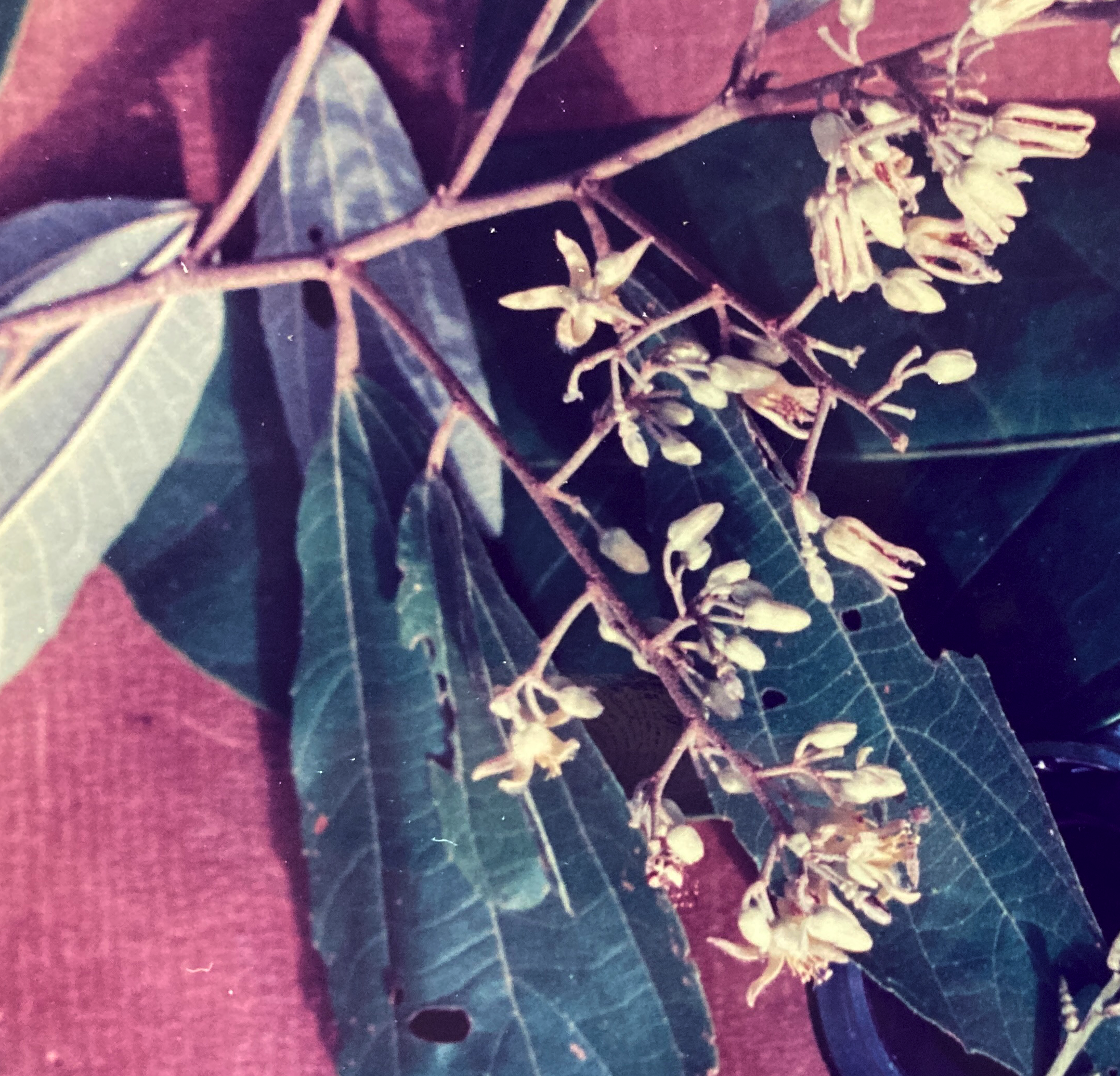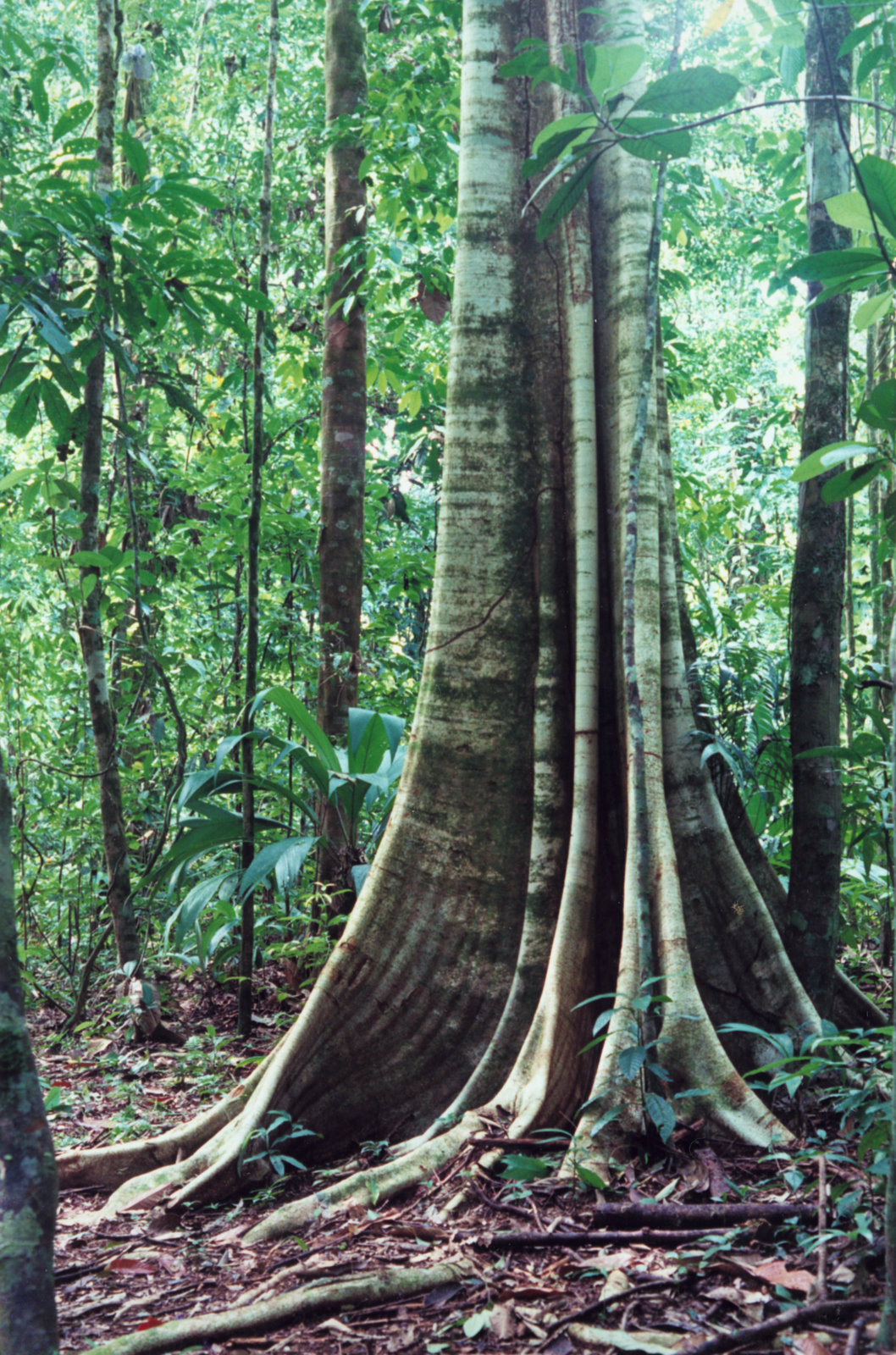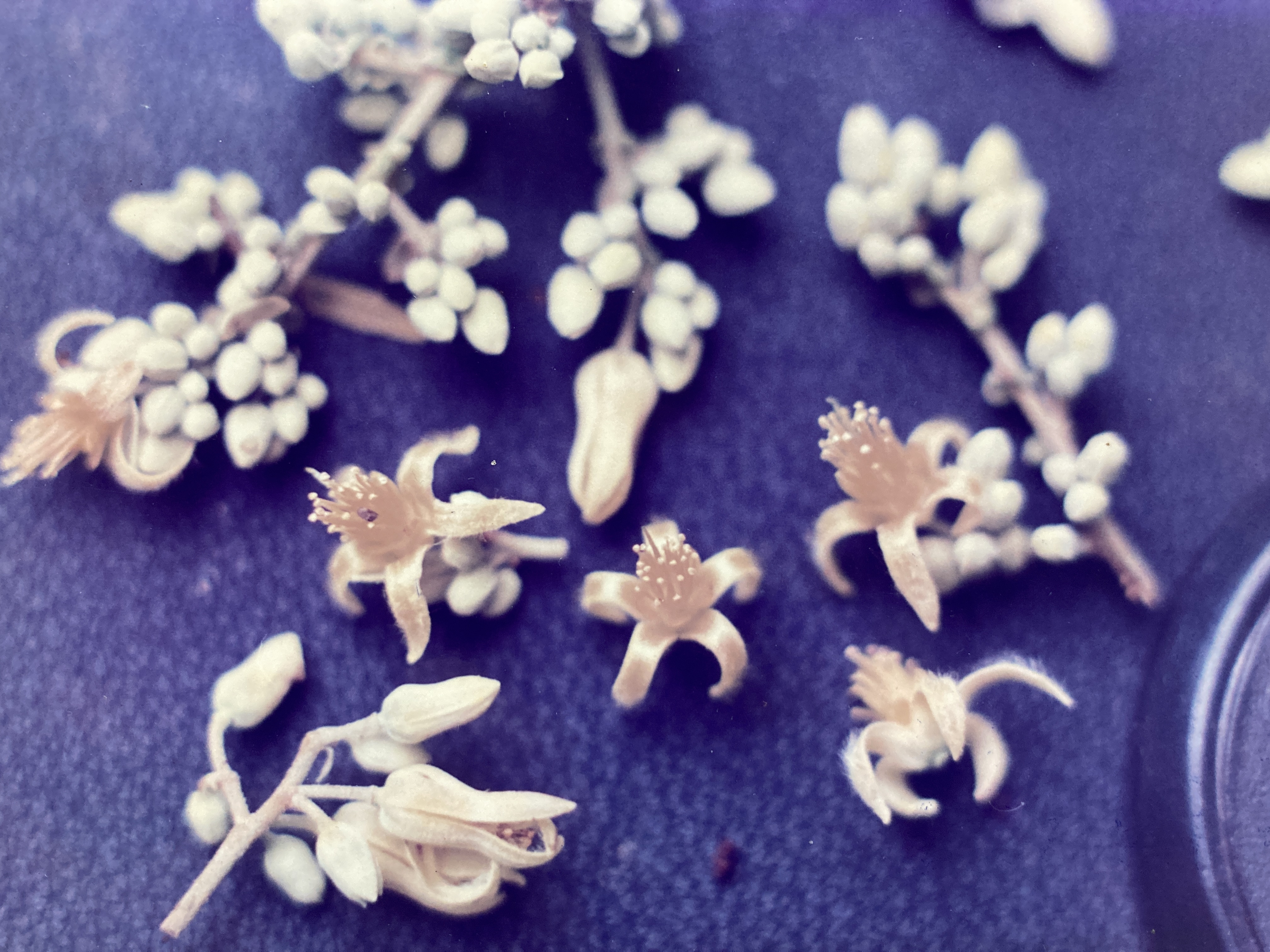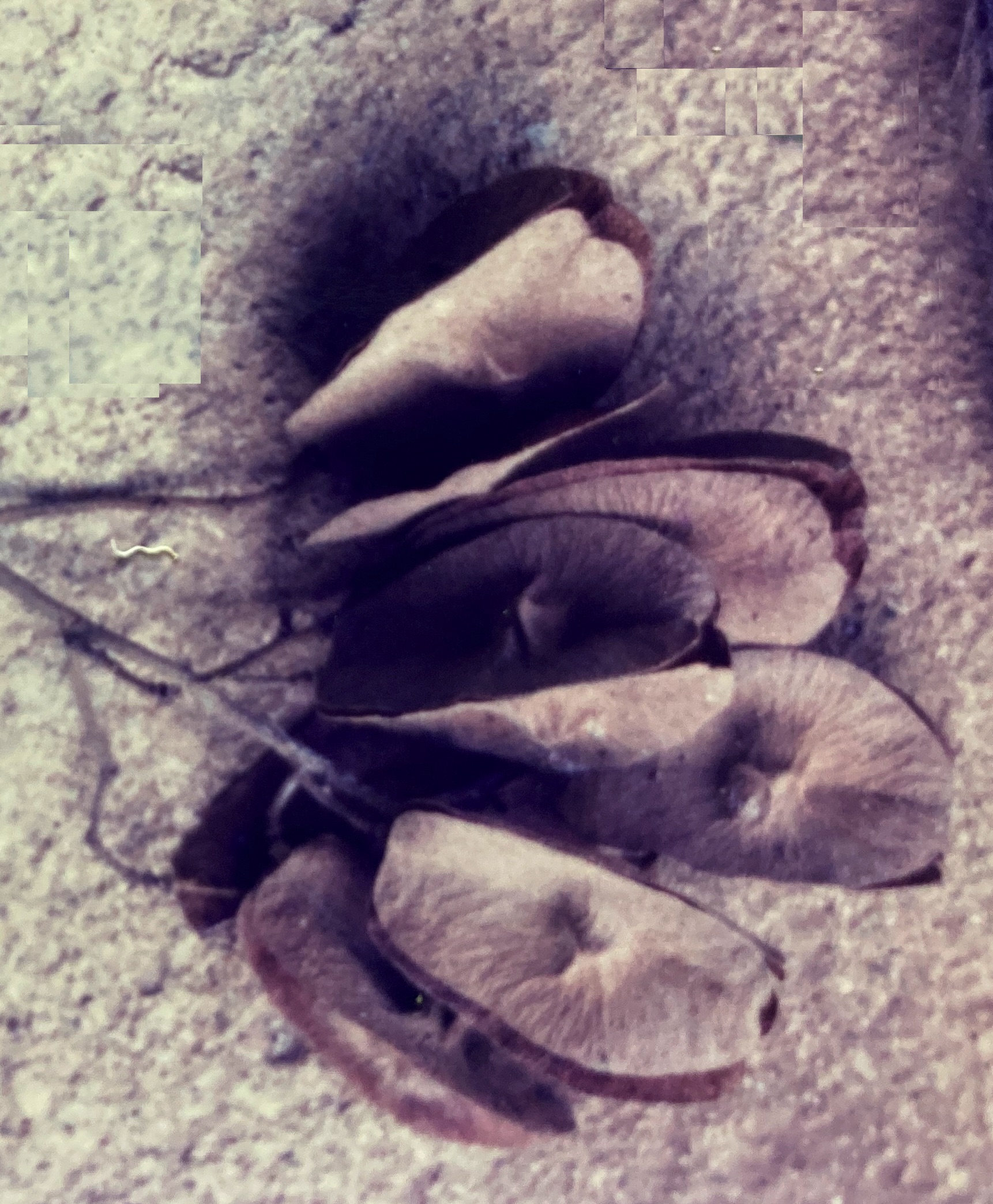Goethalsia meiantha (Donn. Sm.) Burret
CHANCHO BLANCO
Occasional evergreen (or briefly deciduous) subcanopy (or rarely canopy) tree (15-30 m) most commonly associated with sunny, disturbed, or secondary forest sites. Large individuals may nevertheless be found thriving amid primary vegetation. Goethalsia produces copious quantities of aromatic, yellow flowers whose characteristically sweet send permeates the forest and attracts many insects. Later, innumerable winged seeds appear, remaining high in the canopy for the better part of the year.
Description: Goethalsia has a cylindrical, straight trunk (30-50 cm). Lacking on young trees, larger individuals develop remarkably thin, gently-sloping, fin-like buttresses that add greatly to the tree’s stability (and esthetic appeal). Boles are clad in smooth, pale-green or creme colored bark composed of tough fibers that are extremely difficult to sever. Goethalsia‘s abundant but fine limbs grow steeply upwards and produce a dense, compact, narrow crown. Leaves (17 cm by 6.5 cm) are simple and alternately arranged on either side of a zig-zag twig, lying in a single plain (two-ranked). They are largely elliptical in shape (but have their widest point shifted somewhat distally from center) and possess well developed drip-tips (1 cm). An unusual leaf vein pattern is dominated by three main ribs that extend the whole length of the serrate blade and unite at the petiole (1 cm). Leaf undersurfaces, veins, petioles and twigs are all covered by a dense, tan-colored, but very short and fine pubescence. As a result, upper and lower leaf surfaces differ markedly in their dark green and tan colors, respectively. During March, all (or most) foliage is shed and in April a dramatic period of regeneration begins. Glossy, pinkish or tawny leaves appear from the ends of the branches and expand rapidly. By May, the Goethalsia canopy has been renewed, but active growth continues through June, culminating in the production of flowers later that month.
Flowers (1 cm) grow from large terminal and subterminal panicles. Buds are protected by three creme-colored sepals that fall early, exposing five narrow and pubescent yellow petals. These bend sharply back toward the rear of the flower and away from a compact central mass of numerous, unequal stamens and a single, green pistil. Once underway, flowering is profuse and sustained – lasting from mid-July through September. The blossoms emit a strongly sweet odor that is quite notable from the ground during the months of peak activity. Flowering in Goethalsia is a precisely timed, annual event and it shows a high degree of synchronization between individuals of the local population.
Fruits (3 cm), green or pink at first, appear almost immediately and reach full size within about a month. Compound structures, they are composed of three united samaras, each with an oval wing surrounding a centrally located seed (4 mm). Aligned longitudinally and joined by their seeds, the three samaras are pressed together, forming what appears to be single seed with three, papery, radially-oriented fins. Fruits continue to accumulate – held high above the foliage – until flowering is complete. By December, the first ones have begun to dry and turn brown. Still quite firmly attached to the trees however, they must rely on strong winds to remove and disperse them. Many seeds remain in the canopies during the entire dry season, only finally falling with the first rains of May – well after the next round of leaf growth has begun. Seeds germinate with the first drenching rains of the wet season (in May and June).
Similar Species: Most species of Tiliaceae possess similarly shaped, two-ranked leaves and, based on this characteristic alone, Goethalsia might be confused with Piene de Mico (Apeiba tibourbou) or, less likely, Guacimo Colorado (Luehea seemannii). The persistence of winged seeds high in the Goethalsia canopy for ten months of the year (excluding only June and July – when leaf growth and flowering are in progress) should make this tree easy to distinguish.

Natural History: The terminal position of Goethalsia‘s flower panicles and the vertical growth habit of its branches ensure that the blossoms will be held well above the obscuring canopy of leaves. Thus exposed and prone, their bright color and strong scent reach a host of insect pollinators. Indeed, hoards of wasps, bees, moths and other insects swarm around these blossoms during the peak flowering season months of August and September. When samaras replace the blossoms, their similarly exposed situation helps to dry them out. The subsequent probability that a passing gust of wind will tear the winged seeds loose is also increased, improving seed dispersal. The relatively robust ties responsible for securing the fruits to the twigs serve to ensure that only strong wind gusts will succeed in detaching them – gusts that are also capable of transporting the samaras significant distances.
Uses: Allen (1956) notes, interestingly, that the fruits of this species are eaten by Scarlet Macaws and that – at the time and place he was writing (Palmar Norte) – these birds would noisily congregate in Goethalsia trees. (Deforestation has long since relegated these persecuted birds to the Corcovado area of the Osa Peninsula). He also says that the wood is light and straight-grained but not durable.
Distribution: In Manuel Antonio National Park (MANP), Goethalsia is located along trail and roadsides where the vegetation has been disturbed and light levels are high. A few individuals have been found growing in primary forests as well – possibly marking the sites of old light gaps produced by natural tree falls. In Costa Rica, the tree is also known from Corcovado and Punta Leona. One particularly impressive specimen (70 cm in diameter and 30 m tall), seen in the northern Osa Peninsula, was large enough to call into doubt – if not the secondary nature of this species – at least its fit with the prototypical stereotype. The tree ranges from Costa Rica into South America (Quesada, 1997).
Images: Trunk Trunk2 Trunk3 Flower & Leaf Flower Flower2 Fruit



